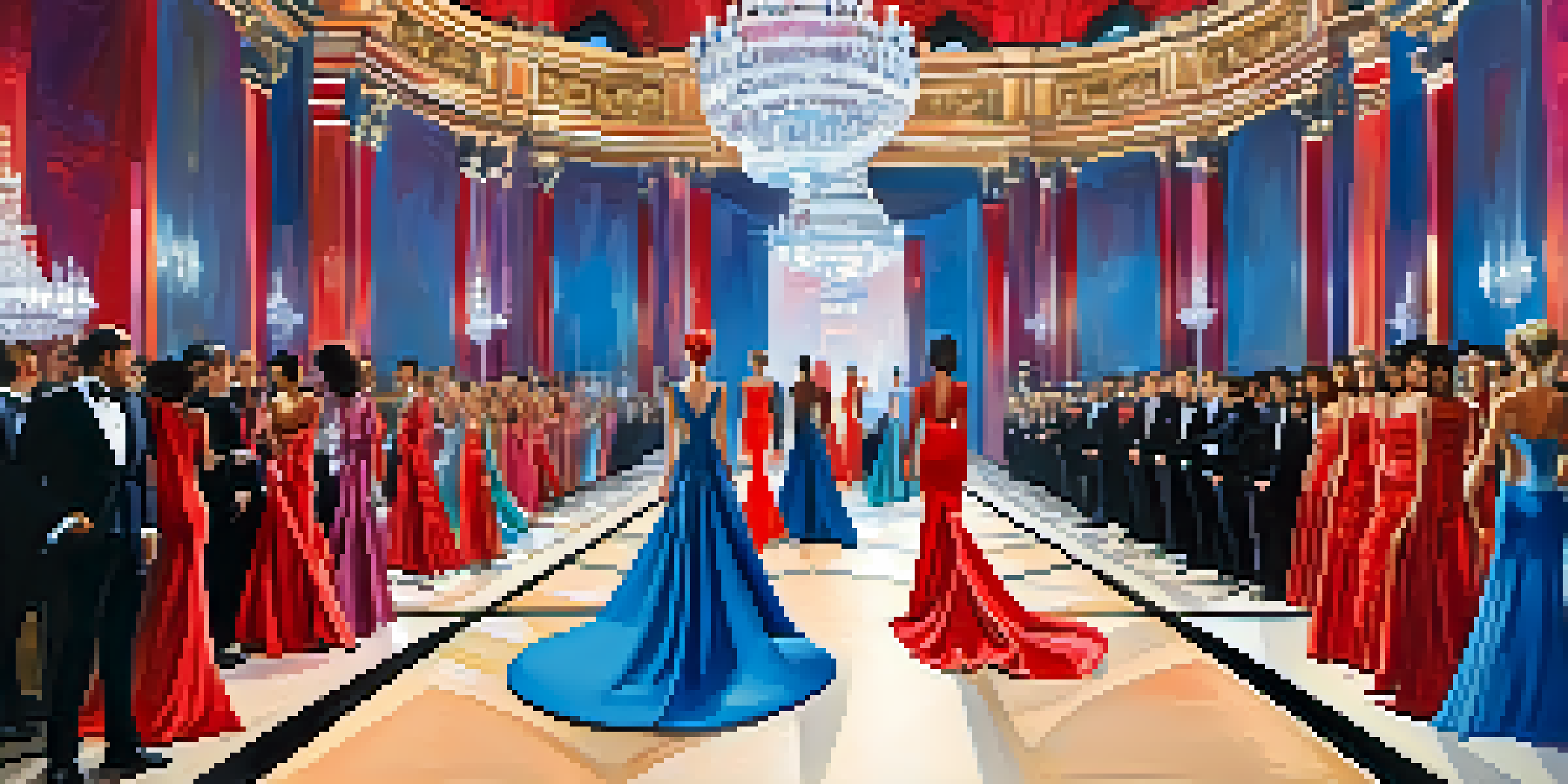The Impact of Fashion Shows on Consumer Buying Behavior

Understanding the Role of Fashion Shows in the Industry
Fashion shows are more than just glamorous events; they are a crucial part of the fashion industry. Designers use these platforms to showcase their latest collections, often setting the tone for upcoming trends. The spectacle of runway models and high-profile attendees creates a buzz that resonates beyond the venue, influencing consumer perceptions.
Fashion is the armor to survive the reality of everyday life.
These events serve as a bridge between creators and consumers, providing a first look at what will soon be available in stores. For many fashion enthusiasts, attending a fashion show is like getting a backstage pass to the world of style. This exclusive experience often instills a sense of urgency and desire to purchase items as soon as they become available.
Moreover, fashion shows often feature innovative designs that may not be commercially available immediately, sparking interest and excitement. This anticipation can drive consumers to engage with brands more actively, whether through social media or direct purchases, highlighting the powerful connection between runway shows and consumer behavior.
The Psychological Impact of Fashion Shows on Consumers
Fashion shows have a unique way of appealing to consumers' emotions and aspirations. The artistry and creativity displayed on the runway evoke feelings of admiration and desire, which can lead to increased purchasing intent. Consumers often associate the glamour of fashion shows with status and exclusivity, creating a mental link that can drive their buying decisions.

Additionally, the social proof that comes from seeing influential figures and celebrities at these events can sway consumer opinions. When a favorite celebrity is seen donning a particular outfit, fans are often inspired to replicate that look, reinforcing the idea that fashion shows shape personal style choices. This phenomenon illustrates the strong relationship between visual culture and consumer behavior.
Fashion Shows Drive Consumer Trends
Fashion shows are pivotal in shaping consumer desires and trends, influencing what styles are sought after in retail.
Ultimately, the emotional connection established during fashion shows can linger long after the event, influencing consumers' shopping habits for months. This impact highlights the importance of understanding consumer psychology within the fashion industry, as it directly correlates with sales and brand loyalty.
The Role of Social Media in Amplifying Fashion Show Influence
In today's digital age, social media plays a pivotal role in amplifying the effects of fashion shows. Platforms like Instagram and TikTok allow attendees to share real-time updates, turning runway moments into viral content. This immediate sharing not only broadens the audience for fashion shows but also transforms them into interactive experiences.
Fashion is about dreaming and making other people dream.
Consumers now have the power to engage with brands directly through social media, often leading to spontaneous purchases influenced by what they see online. The 'see now, buy now' trend has emerged, where consumers expect to purchase items shortly after they see them on the runway. This shift in consumer behavior emphasizes the need for brands to be agile and responsive to capitalize on the moment.
Moreover, influencers and fashion bloggers leverage their platforms to provide commentary and insights on fashion shows, further shaping consumer perceptions. Their opinions can sway audiences and create a sense of credibility that drives purchasing decisions, illustrating how interconnected fashion shows and digital marketing have become.
How Fashion Shows Shape Trends and Consumer Preferences
Fashion shows are often the birthplace of new trends, influencing what consumers desire in their wardrobes. Designers use these events to experiment with bold styles, colors, and silhouettes, which can quickly become the next big thing. As consumers witness these innovations, they become motivated to adopt similar styles, driving demand in the retail market.
This trend-setting power is particularly evident in fast fashion, where brands rapidly produce and distribute styles inspired by recent runway shows. Consumers may not always realize that their choices are influenced by what they see on the catwalk, but the connection is undeniable. The cycle of inspiration from runway to retail is a powerful driver of consumer behavior.
Social Media Amplifies Fashion Impact
The rise of social media has transformed fashion shows into interactive experiences, allowing real-time engagement and immediate consumer responses.
Furthermore, the evolution of trends showcased at fashion shows often reflects broader societal changes and consumer attitudes. When designers incorporate elements of sustainability or inclusivity into their collections, they not only make a statement but also resonate with consumers' values, influencing their buying decisions.
The Economic Impact of Fashion Shows on Retail Sales
The economic ramifications of fashion shows extend beyond mere aesthetics; they significantly impact retail sales. When a fashion show showcases a collection, it often leads to a surge in interest and pre-orders for those items, providing a boost to brands' revenue. This spike in consumer interest can also enhance a brand's visibility and desirability in a competitive market.
Additionally, successful fashion shows can lead to collaborations and partnerships that further drive sales. Brands often create limited-edition items or capsule collections in response to the buzz generated by their runway presentations. These exclusive offerings create a sense of urgency among consumers, encouraging them to make quick purchasing decisions.
Moreover, the media coverage surrounding fashion shows can enhance brand recognition, translating into increased foot traffic in stores and online. The ripple effect of a well-executed fashion show can lead to long-term financial benefits, underscoring the importance of these events in the fashion industry.
The Influence of Cultural Context on Fashion Shows
Cultural context significantly influences how fashion shows are perceived by consumers. Different regions may prioritize various styles, aesthetics, and cultural references, impacting how collections are received. For instance, a fashion show in Paris may highlight haute couture and luxury, while a show in Tokyo might focus on street fashion and innovation.
This cultural backdrop not only shapes the designs presented but also informs consumer expectations and reactions. When fashion shows authentically reflect local culture, they resonate more deeply with audiences, driving interest and purchases. This connection emphasizes the need for designers to be aware of the cultural dynamics at play in their target markets.
Cultural Context Shapes Fashion Perception
Cultural factors significantly influence how fashion shows and their collections are received, highlighting the need for designers to align with local values.
Ultimately, understanding cultural context can enhance a brand's ability to connect with consumers on a more personal level. By aligning their collections with cultural values and aesthetics, brands can foster loyalty and encourage repeat purchases, illustrating the symbiotic relationship between culture and consumer behavior in fashion.
The Future of Fashion Shows and Consumer Engagement
As the fashion industry evolves, so too do fashion shows and their impact on consumer behavior. The rise of digital technology and virtual events has transformed the traditional fashion show format, making it more accessible to a broader audience. This shift opens up new avenues for consumer engagement, allowing brands to connect with potential buyers in innovative ways.
With the incorporation of augmented reality and interactive experiences, future fashion shows may provide consumers with the ability to visualize themselves in the showcased designs. This level of personalization can enhance the buying experience, making it more engaging and memorable for consumers. As a result, brands that embrace these technologies may find themselves ahead of the curve.

Moreover, the emphasis on sustainability and ethical practices in fashion is likely to shape the future of fashion shows. Consumers are increasingly seeking transparency and responsibility in their purchasing decisions, prompting brands to adapt their messaging and offerings. This evolving landscape highlights the importance of staying attuned to consumer values and preferences to maintain relevance in the industry.